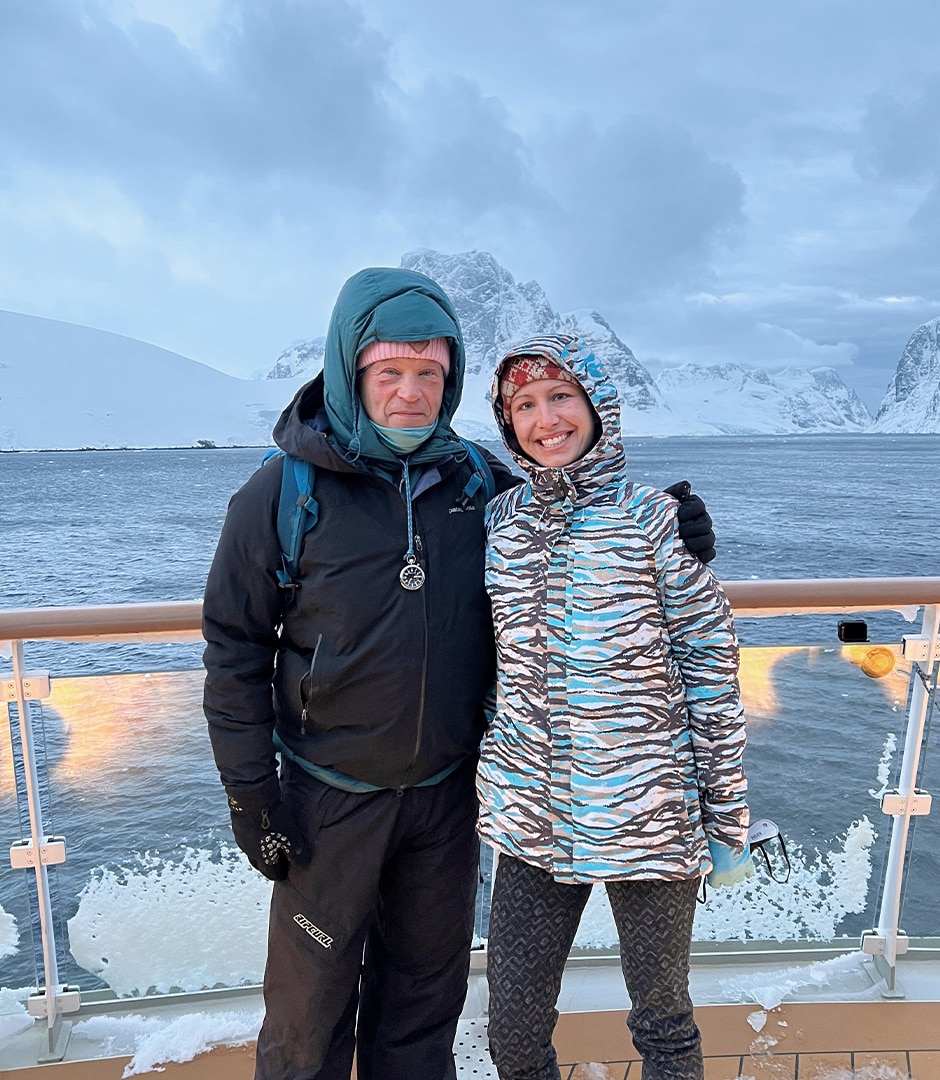5 questions for polar ice caps expert Robert Swan
The champion of the 2041 Foundation explains his mission to protect Antarctica with the help of a new generation of environmental activists.
June 28, 2022 - Michele Malejki
Three decades ago, polar explorer Robert Swan became the first person to walk to both the North and South Poles. Since his epic trek, he has dedicated himself to protecting those regions by bringing others along. He has personally led 35 expeditions to Antarctica as the founder of 2041 Foundation, a nonprofit organization dedicated to preserving Antarctica for science and research. The world’s moratorium on mining there ends in 19 years, and Swan’s mission is to ensure those treaties are renewed and Antarctica is protected forever.

HP's Global Head of Social Impact Michele Malejki with Swan.
His latest trip, in March 2022, with adventure travel operator The Explorer’s Passage saw a global group of 170 people aboard Albatros Expeditions’ Ocean Victory, an environmentally friendly, low-energy vessel. The ship wasn’t packed with wealthy tourists, but rather a mix of voyagers from the public, private, and civil sectors—including marginalized and historically excluded individuals. Among the group were business leaders like Mark Jones of renewable energy company Ventient Energy; artists like Danii Kehler, a member of the Kawacatoose First Nations; and climate justice advocates like Zanagee Artis, executive director of Zero Hour and author of A Kids Book about Climate Change. Many of the young people were awarded scholarships to join the expedition.
RELATED: HP volunteers offer help and hope to displaced Ukrainians
Michele Malejki, HP’s Global Head of Social Impact, joined the voyage as part of a leadership team that gave presentations on topics such as environmental justice and girls’ education as a mitigant to climate change. Here, she asks Swan about his drive to preserve this pristine landscape and what gives him hope for the future.
Michele Malejki: Why did you create the 2041 Foundation and what are its goals?
Robert Swan: Thirty-one years ago, after I managed to walk to the South Pole and the North Pole, Jacques Cousteau personally gave me a mission to make sure that Antarctica remains a natural reserve, a place only for science and peace, belonging to no country. We have one chance left to show future generations that we’re capable of leaving one place on the planet alone. Until recently I was just focused on the preservation of the Antarctic continent, but gradually I realized that people need saving, too. Antarctica has 90% of the world’s ice and 70% of the world’s fresh water. If the ice melts, the sea level around the world will rise an estimated 300 feet, which will be catastrophic.
Left: The Fish Islands are home to thousands of Adelie penguins. Right: Navigating through the ice in Fournier Bay.
What do you hope the expedition accomplished?
Each expedition has two purposes. One is that all the participants will in 19 years become champions of the future to preserve and protect Antarctica. If you divide the area of Antarctica by the number of people on the planet, we are all responsible for a piece about the size of a football pitch. The other is to give everyone on board the knowledge, skills, and tools to help with sustainability back in their home countries, enforce the use of renewable energy, and prevent further climate warming. With widespread use of renewables, it also won’t make financial sense to mine for coal or drill for oil or gas in Antarctica.
Why is it so important to ensure that young people from around the world see Antarctica?
It is crucial to inspire young leaders so they can share this story with other youth or even old people like me. We had 170 people from nearly 40 countries on board our ship, and they’re able to support each other when they get home, not just for Antarctica, but for their own projects and their own personal missions.
A minke whale puts on a show near Neko Harbour.
What should those interested in journeying to Antarctica consider, whether they are a CEO or a politician or a traveler?
First, they need to make sure their travel is as carbon neutral as possible and follow strict guidelines so physically they don’t make any impact on
the landscape. Second, support people like us who are trying to protect this extraordinary place. And lastly, use their expedition story to do that—go forth and get the message out to preserve it. Because we need people to know what will be lost if they don’t.
As you look ahead to 2041, what gives you energy and optimism?
When you’re a polar explorer like me who goes to the heart of Antarctica, if you don’t have hope, you die. It’s important that one has inspiring stories that can engage the broadest number of people possible, not just the C-suite or the people in power. It would be really easy for us to be negative and tell spectacularly bad stories to get people’s attention. But we have to be positive and tell hopeful stories. That’s one of the reasons that we’re going back to the South Pole at the end of this year. We can show people we’re following through and using new innovations and technologies like fuel from carbon in the atmosphere. Our expedition is about spreading hope in a world that’s rather gloomy right now.


